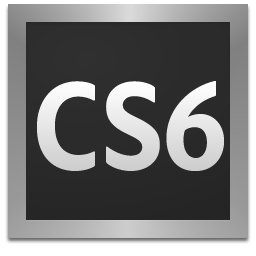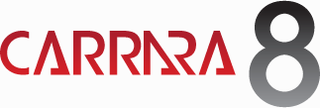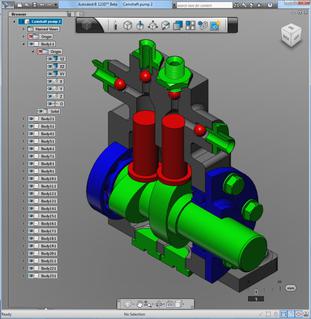Adobe Flash is a deprecated multimedia software platform used for production of animations, rich Internet applications, desktop applications, mobile applications, mobile games and embedded web browser video players. Flash displays text, vector graphics and raster graphics to provide animations, video games and applications. It allows streaming of audio and video, and can capture mouse, keyboard, microphone and camera input. Related development platform Adobe AIR continues to be supported.

Adobe Photoshop is a raster graphics editor developed and published by Adobe Inc. for macOS and Windows. It was originally created in 1988 by Thomas and John Knoll. Since then, this software has become the de facto industry standard not only in raster graphics editing, but to digital art as a whole; it even went to the point that the software's name itself has become a generic trademark, leading to its usage as a verb although Adobe discourages such use. Photoshop can edit and compose raster images in multiple layers and supports masks, alpha compositing, and several color models including RGB, CMYK, CIELAB, spot color, and duotone. Photoshop uses its own PSD and PSB file formats to support these features. In addition to raster graphics, this software has limited abilities to edit or render text and vector graphics, as well as 3D graphics and video. Its feature set can be expanded by plug-ins; programs developed and distributed independently of Photoshop that run inside it and offer new or enhanced features.

QuarkXPress is a desktop publishing software for creating and editing complex page layouts in a WYSIWYG environment. It runs on macOS and Windows. It was first released by Quark, Inc. in 1987 and is still owned and published by them.

Adobe Illustrator is a vector graphics editor developed and marketed by Adobe Inc. Originally designed for the Apple Macintosh, development of Adobe Illustrator began in 1985. Along with Creative Cloud, Illustrator CC was released. The latest version, Illustrator CC 2019, was released in October 2018 and is the 23rd generation in the product line. Adobe Illustrator was reviewed as the best vector graphics editing program in 2018 by PC Magazine.

Adobe GoLive was a WYSIWYG HTML editor and web site management application from Adobe Systems. It replaced Adobe PageMill as Adobe's primary HTML editor and was itself discontinued in favour of Dreamweaver. The last version of GoLive that Adobe released was GoLive 9.

Adobe Creative Suite (CS) is a now-discontinued software suite of graphic design, video editing, and web development applications developed by Adobe Systems. Each edition consisted of several Adobe applications, e.g., Photoshop, Acrobat, Premiere Pro or After Effects, InDesign, and Illustrator that are the industry standard applications for many graphic design positions.

Poser is a 3D computer graphics program distributed by Smith Micro Software. Poser is optimized for 3D modeling of human figures and has gained popularity due to beginners being able to produce basic animations and digital images, as well as the extensive availability of third-party digital models.

Adobe Audition is a digital audio workstation from Adobe Systems featuring both a multitrack, non-destructive mix/edit environment and a destructive-approach waveform editing view.

ActionScript is an object-oriented programming language originally developed by Macromedia Inc.. It is a derivation of HyperTalk, the scripting language for HyperCard. It is now a dialect of ECMAScript, though it originally arose as a sibling, both being influenced by HyperTalk.
Adobe Shockwave is a multimedia platform for building interactive multimedia applications and video games. Developers originate content using Adobe Director and publish it on the Internet. Such content can be viewed in a web browser on any computer with the Shockwave Player plug-in installed. Macromind originated the technology; Macromedia developed it further, releasing Shockwave Player in 1995. Adobe Systems acquired Shockwave in 2005. Shockwave supports raster graphics, basic vector graphics, 3D graphics, audio, and an embedded scripting language called Lingo.

Adobe Flash Player is computer software for using content created on the Adobe Flash platform, including viewing multimedia contents, executing rich Internet applications, and streaming audio and video. Flash Player can run from a web browser as a browser plug-in or on supported mobile devices. Flash Player was created by Macromedia and has been developed and distributed by Adobe Systems since Adobe acquired Macromedia in 2005. Flash Player is distributed as freeware or, in China, as adware.

Adobe Flash Lite is a lightweight version of Adobe Flash Player, a software application published by Adobe Systems for viewing Flash content. Flash Lite operates on devices that Flash Player cannot, such as mobile phones and other portable electronic devices like Wii, Chumby and Iriver.

The Extensible Metadata Platform (XMP) is an ISO standard, originally created by Adobe Systems Inc., for the creation, processing and interchange of standardized and custom metadata for digital documents and data sets.

Adobe Lightroom is a family of image organization and image manipulation software developed by Adobe Systems for Windows, macOS, iOS, Android, and tvOS. It allows importing/saving, viewing, organizing, tagging, editing, and sharing large numbers of digital images. Unlike Photoshop, Lightroom's edits are always non-destructive by keeping the original image and the edits applied to it saved separately. Despite sharing its name with Adobe Photoshop, it cannot perform many Photoshop functions such as doctoring, rendering text or 3D objects on images, or modifying individual video frames. Lightroom is not a file manager like Adobe Bridge. It cannot operate on files unless they are imported into its database first, and only in recognized image formats.

Carrara is a full-featured 3D computer graphics application featuring figure posing and editing, as well as nature modeling, in addition to traditional modeling, animation, texturing and rendering. The software is also capable of dynamic hair and fur simulations, particle effects, soft body and rigid body dynamics. Carrara is now owned and developed by DAZ 3D. Carrara is compatible with Poser and DAZ format 3D figures and props. It is further supported by a number of 3rd party plug-ins and add-ons.

Aptana, Inc. is a company that makes web application development tools for Web 2.0 and Ajax for use with a variety of programming languages. Aptana's main products include Aptana Studio, Aptana Cloud and Aptana Jaxer.

Photosynth is a discontinued app and service from Microsoft Live Labs and the University of Washington that analyzes digital photographs and generates a three-dimensional model of the photos and a point cloud of a photographed object. Pattern recognition components compare portions of images to create points, which are then compared to convert the image into a model. Users are able to view and generate their own models using a software tool available for download at the Photosynth website.
Shade 3D is a 3D modeling, rendering, animation, 3D printing computer program was developed by e frontier Japan and published by Mirye Software. From 2013 October, Shade 3D development team formed a new company called Shade3D Co.,Ltd. and continue to develop and market the program. After terminated the sales agreement with e frontier Japan and Mirye Software by the end of December 2014, Shade3D company is now developing and marketing Shade 3D products in Japan and worldwide exclusively.

Adobe FreeHand was a computer application for creating two-dimensional vector graphics oriented primarily to professional illustration, desktop publishing and content creation for the Web. FreeHand was similar in scope, intended market, and functionality to Adobe Illustrator, CorelDRAW and Xara Designer Pro. Because of FreeHand's dedicated page layout and text control features, it also compares to Adobe InDesign and QuarkXPress. Professions using FreeHand include graphic design, illustration, cartography, fashion and textile design, product design, architects, scientific research, and multimedia production.

Autodesk 123D was a suite of hobbyist CAD and 3D modelling tools created by Autodesk. It is similar in scope to Trimble SketchUp and is based on Autodesk Inventor. As well as the more basic drawing and modelling capabilities it also has assembly and constraint support and STL export. Available for the software is also a library of ready-made blocks and objects.









